Charles E W Bean, Diaries, AWM38 3DRL 606/251/1 - 1915 - 1936 - Part 24
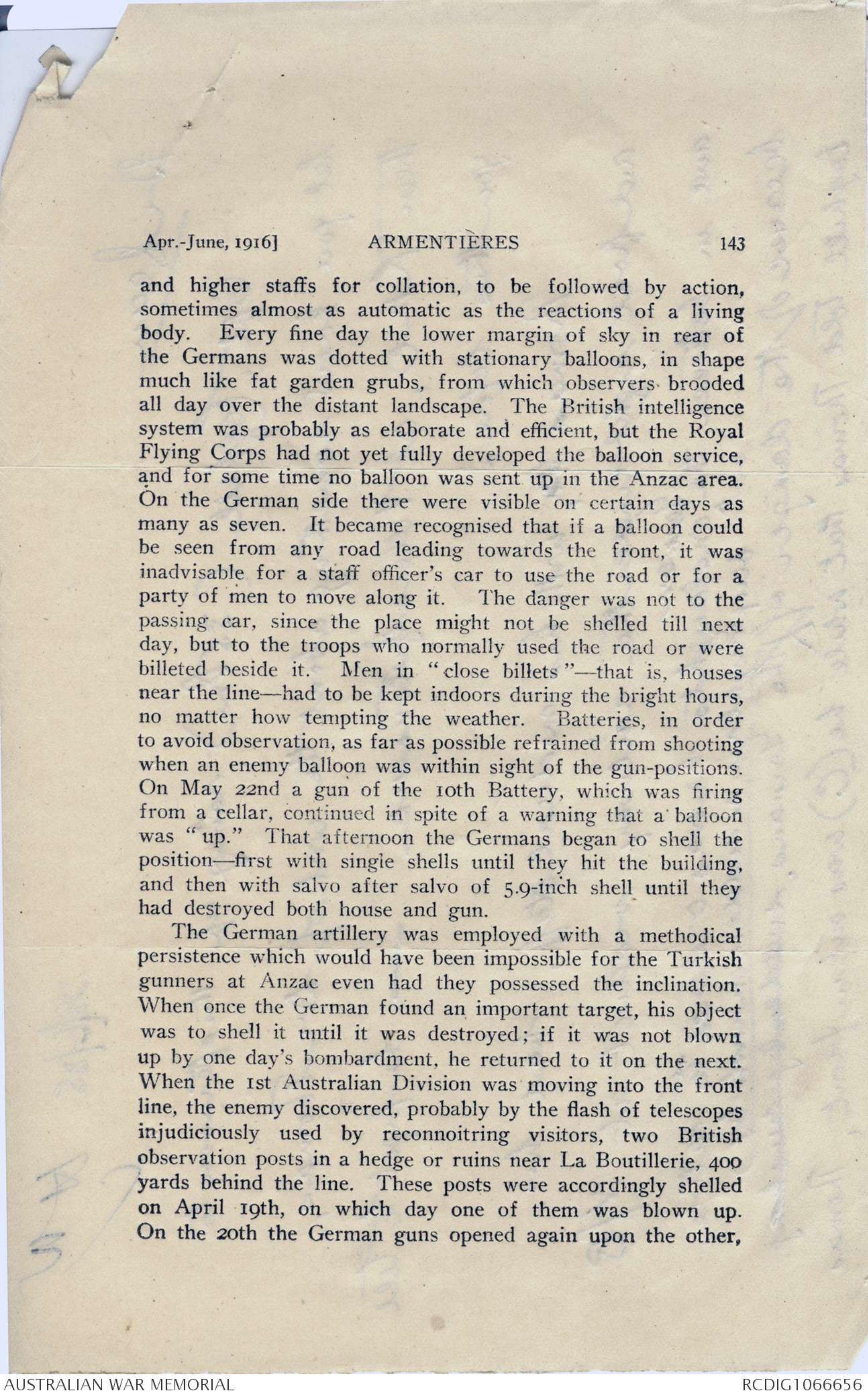
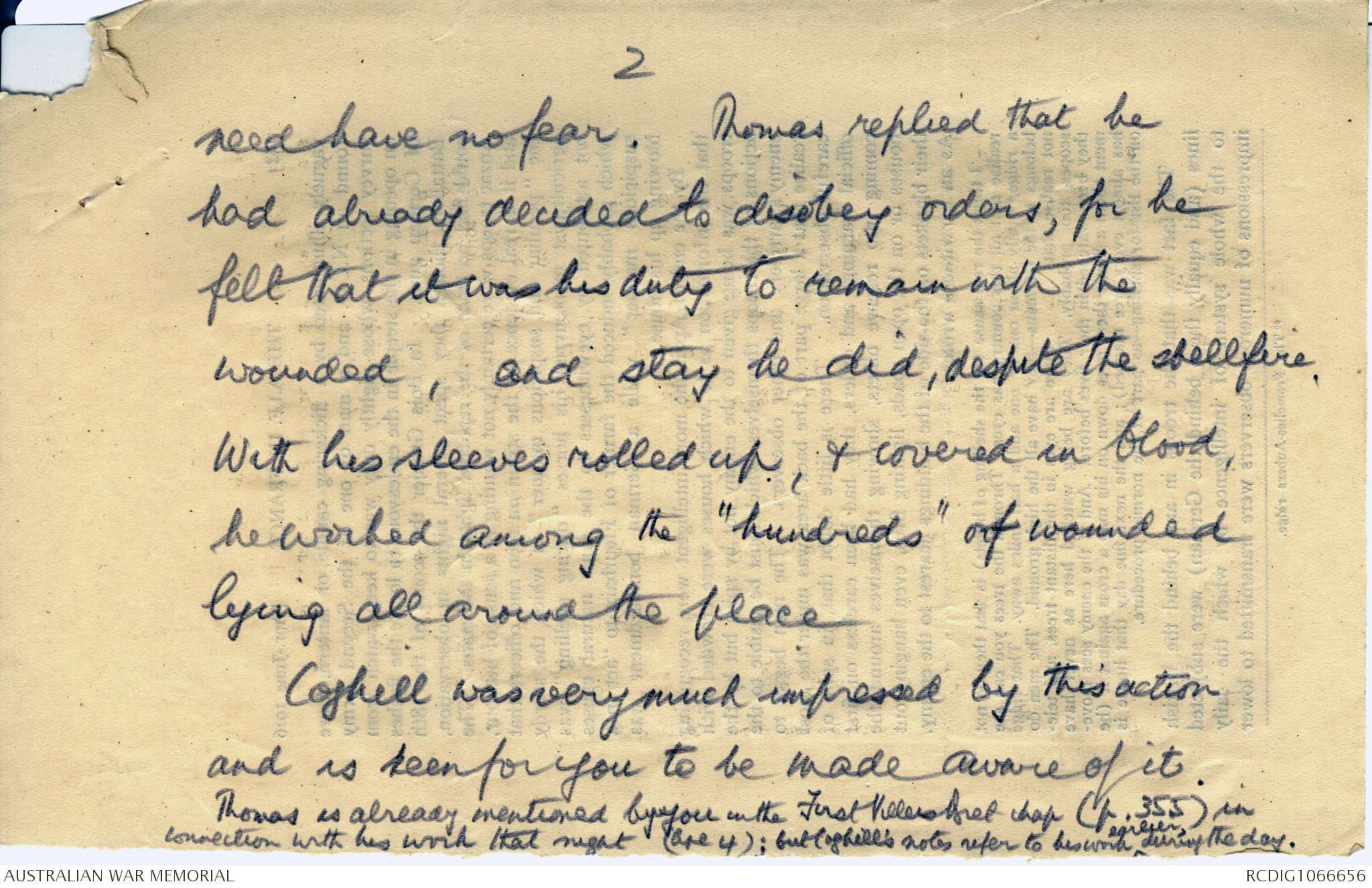
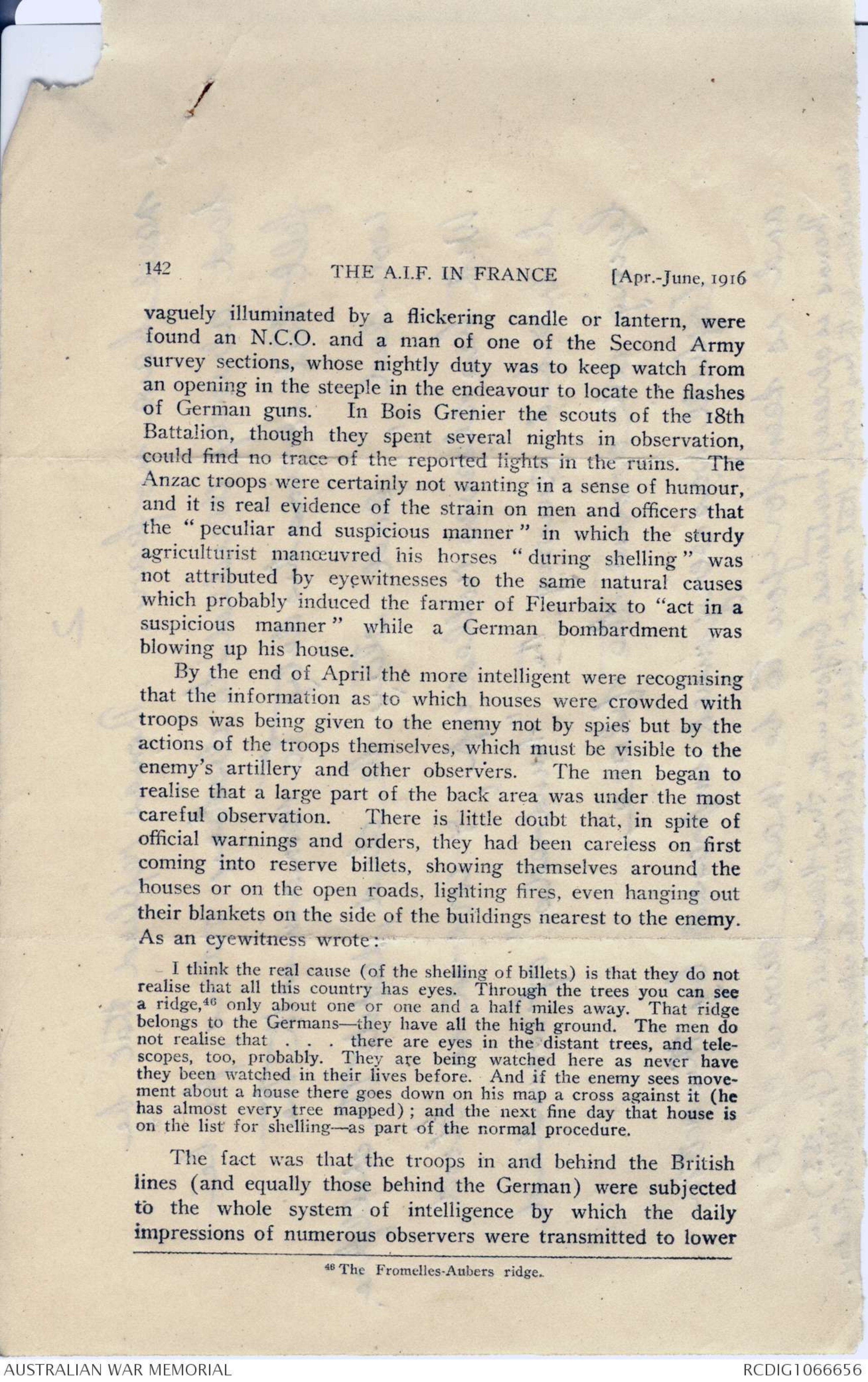
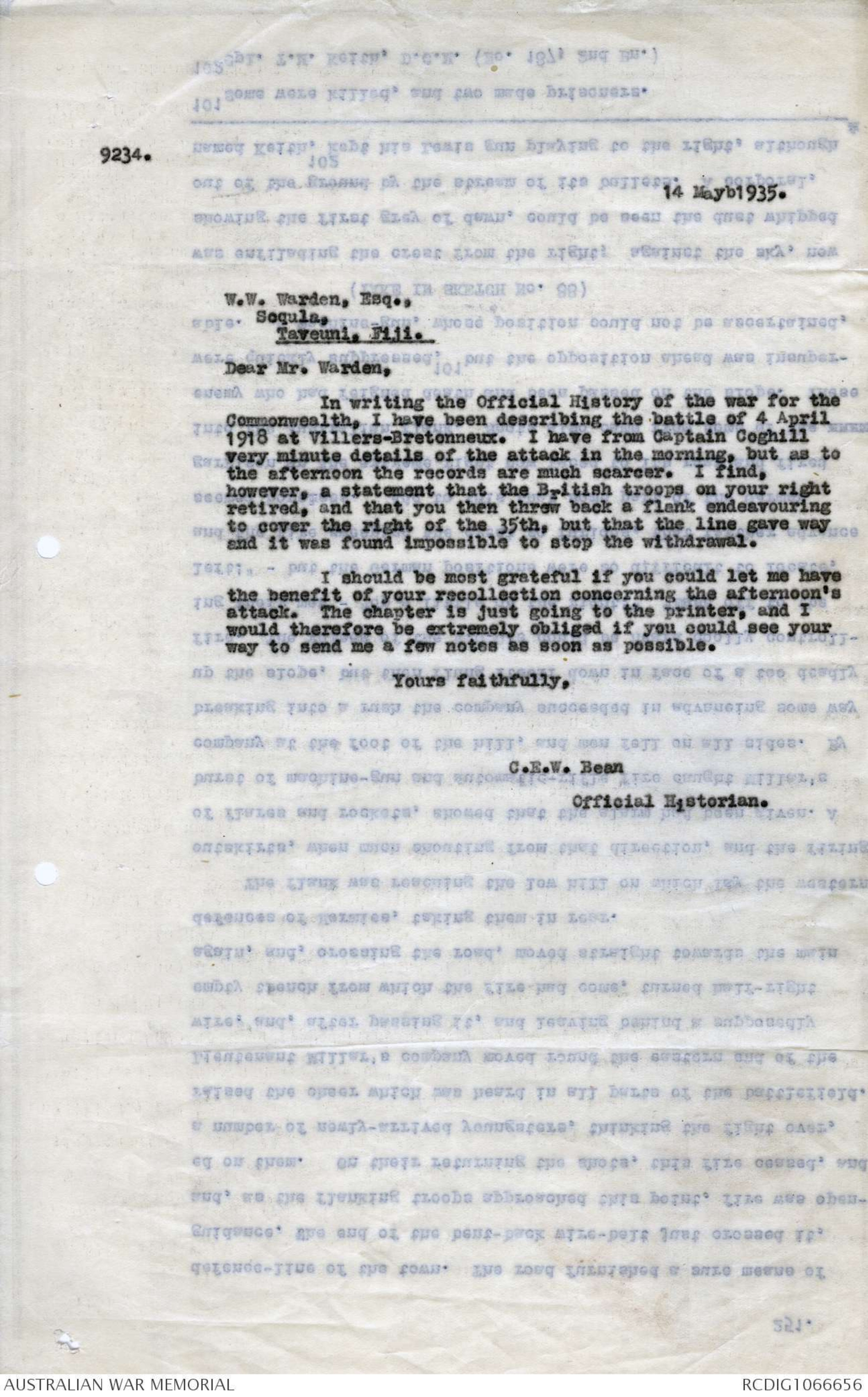
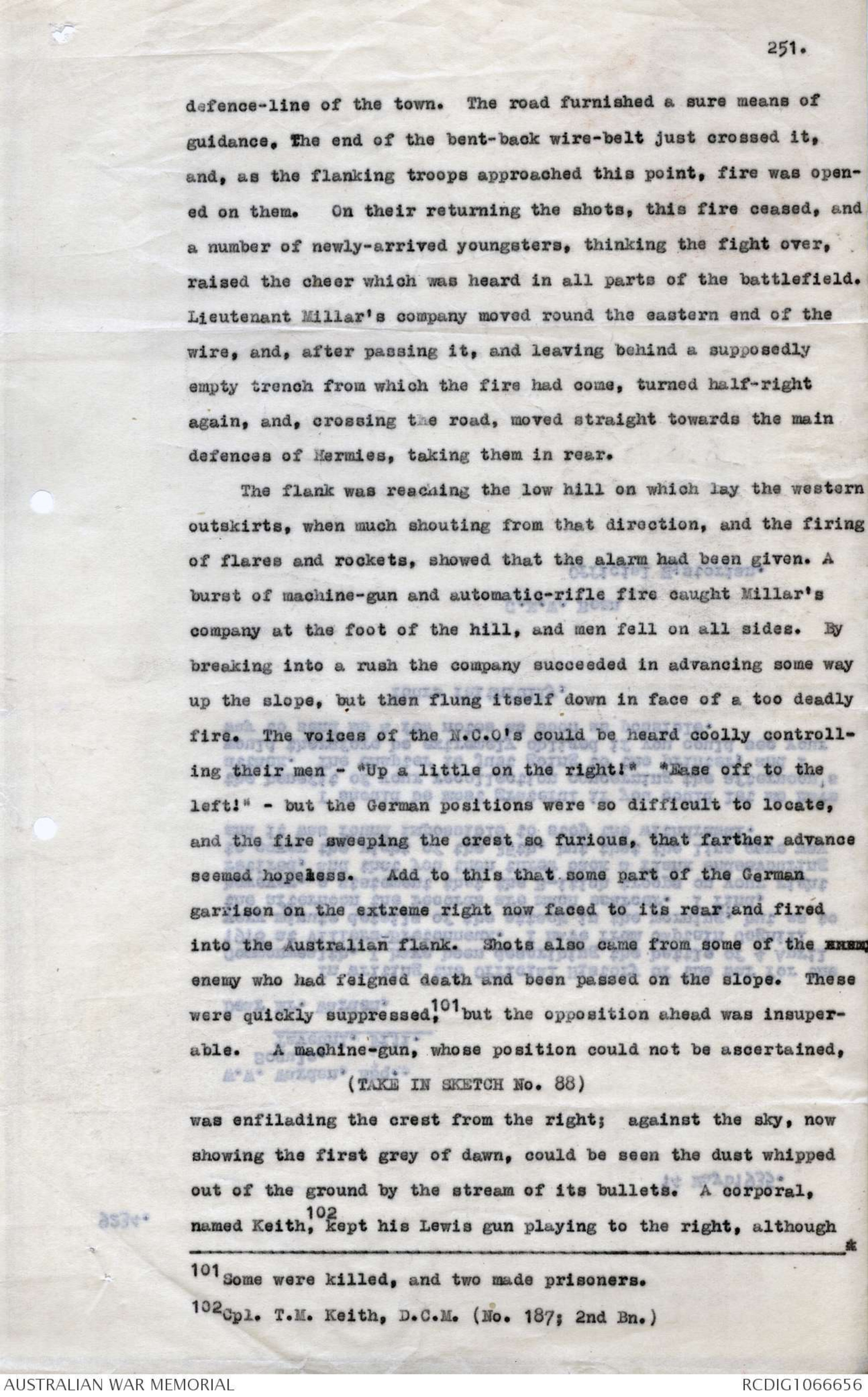
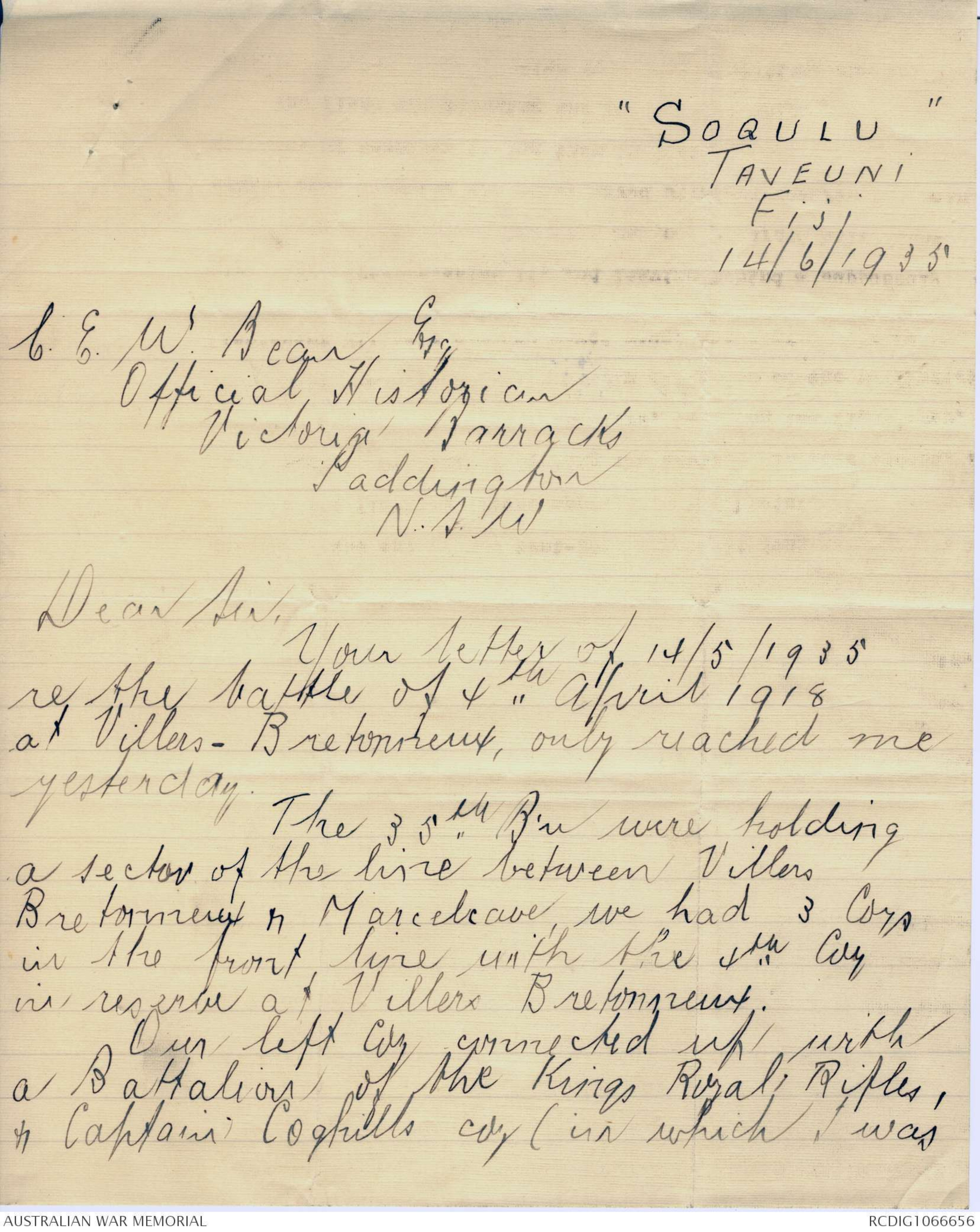

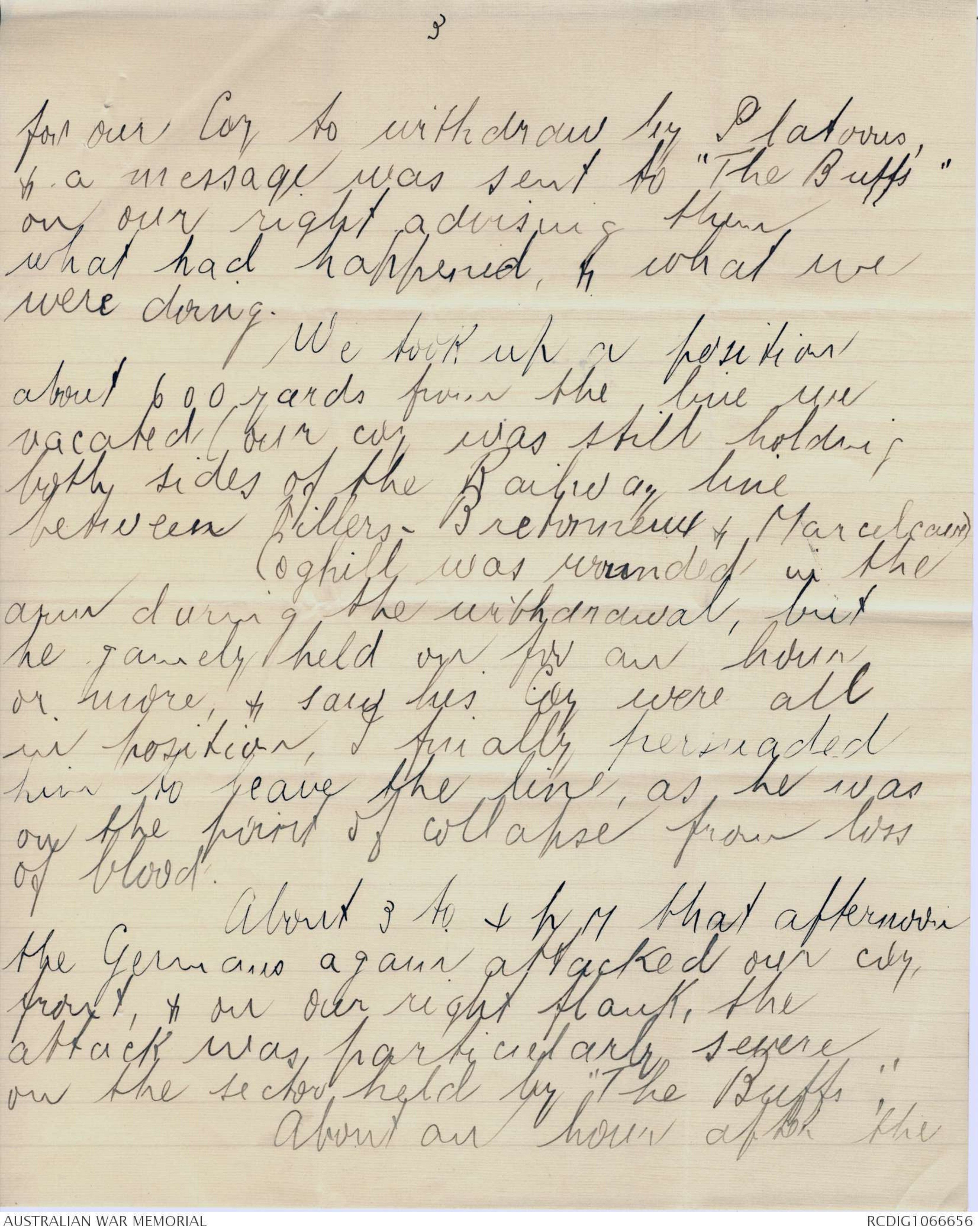

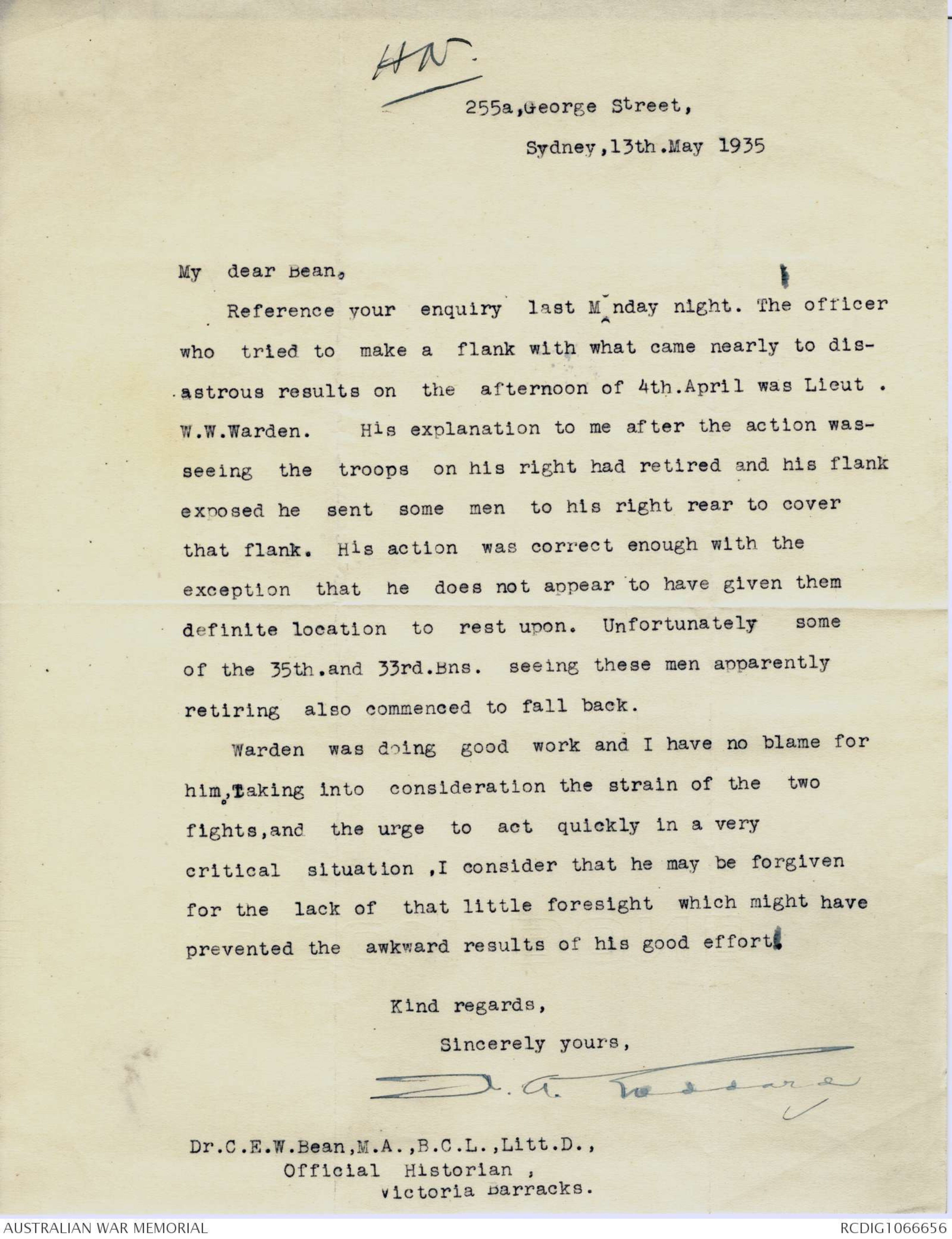
Apr-June, 1916] ARMENTIЀRES 143
and higher staffs for collation, to be followed by action,
sometimes almost as automatic as the reactions of a living
body. Every fine day the lower margin of sky in rear of
the Germans was dotted with stationary balloons, in shape
much like fat garden grubs, from which observers brooded
all day over the distant landscape. The British intelligence
system was probably as elaborate and efficient, but the Royal
Flying Corps had not yet fully developed the balloon service,
and for some time no balloon was sent up in the Anzac area.
On the German side there were visible on certain days as
many as seven. It became recognised that if a balloon could
be seen from any road leading towards the front, it was
inadvisable for a staff officer's car to use the road or for a
party of men to move along it. The danger was not to the
passing car, since the place might not be shelled till next
day, but to the troops who normally used the road or were
billeted beside it. Men in "close billets"—that is, houses
near the line—had to be kept indoors during the bright hours,
no matter how tempting the weather. Batteries, in order
to avoid observation, as far as possible refrained from shooting
when an enemy balloon was within sight of the gun-positions.
On May 22nd a gun of the 10th Battery, which was firing
from a cellar, continued in spite of a warning that a balloon
was "up". That afternoon the Germans began to shell the
position—first with single shells until they hit the building,
and then with salvo after salvo of 5.9-inch shell until they
had destroyed both house and gun.
The German artillery was employed with a methodical
persistence which would have been impossible for the Turkish
gunners at Anzac even had they possessed the inclination.
When once the German found an important target, his object
was to shell it until it was destroyed; if it was not blown
up by one day's bombardment, he returned to it on the next.
When the 1st Australian Division was moving into the front
line, the enemy discovered, probably by the flash of telescopes
injudiciously used by reconnoitring visitors, two British
observation posts in a hedge or ruins near La Boutillerie, 400
yards behind the line. These posts were accordingly shelled
on April 19th, on which day one of them was blown up.
On the 20th the German guns opened again upon the other,
2
need have no fear. Thomas replied that he
had already decided to disobey orders, for he
felt that it was his duty to remain with the
wounded, and stay he did, despite the shellfire.
With his sleeves rolled up, & covered in blood,
he worked among the "hundreds" of wounded
lying all around the place
Coghill was very much impressed by this action
and is keen for you to be made aware of it.
Thomas is already mentioned by you in the First Villers Bret chap (p.355) in
connection with his work that night (Apl 4); but Coghill's notes refer to his work ^earlier during the day.
142 THE A.I.F. IN FRANCE [Apr- June, 1916
vaguely illuminated by a flickering candle or lantern, were
found an N.C.O. and a man of one of the Second Army
survey sections, whose nightly duty was to keep watch from
an opening in the steeple in the endeavour to locate the flashes
of German guns. In Bois Grenier the scouts of the 18th
Battalion, though they spent several nights in observation,
could find no trace of the reported lights in the ruins. The
Anzac troops were certainly not wanting in a sense of humour,
and it is real evidence of the strain on men and officers that
the "peculiar and suspicious manner" in which the sturdy
agriculturist manœuvred his horses "during shelling" was
not attributed by eyewitnesses to the same natural causes
which probably induced the farmer of Fleurbaix to "act in a
suspicious manner" while a German bombardment was
blowing up his house.
By the end of April the more intelligent were recognising
that the information as to which houses were crowded with
troops was being given to the enemy not by spies but by the
actions of the troops themselves, which must be visible to the
enemy's artillery and other observers. The men began to
realise that a large part of the back area was under the most
careful observation. There is little doubt that, in spite of
official warnings and orders, they had been careless on first
coming into reserve billets, showing themselves around the
houses or on the open roads, lighting fires, even hanging out
their blankets on the side of the buildings nearest to the enemy.
As an eyewitness wrote:
I think the real cause (of the shelling of billets) is that they do not
realise that all this country has eyes. Through the trees you can see
a ridge,46 only about one or one and a half miles away. That ridge
belongs to the Germans—they have all the high ground. The men do
not realise that .... there are eyes in the distant trees, and telescopes,
too, probably. They are being watched here as never have
they been watched in their lives before. And if the enemy sees movement
about a house there goes down on his map a cross against it (he
has almost every tree mapped); and the next fine day that house is
on the list for shelling—as part of the normal procedure.
The fact was that the troops in and behind the British
lines (and equally those behind the German) were subjected
to the whole system of intelligence by which the daily
impressions of numerous observers were transmitted to lower
46 The Fromelles-Anbers ridge.
9234.
14 Mayb1935.
W. W. Warden, Esq.
Soqula,
Taveuni, Fiji.
Dear Mr. Warden,
In writing the Official History of the war for the
Commonwealth, I have been describing the battle of 4 April
1918 at Villers-Bretonneux. I have from Captain Coghill
very minute details of the attack in the morning, but as to
the afternoon the records are much scarcer. I find,
however, a statement that the British troops on your right
retired, and that you then threw back a flank endeavouring
to cover the right of the 35th, but, that the line gave way
and it was found impossible to stop the withdrawal.
I should be most grateful if you could let me have
the benefit of your recollection concerning the afternoon's
attack. The chapter is just going to the printer, and I
would therefore be extremely obliged if you could see your
way to send me a few notes as soon as possible.
Yours faithfully.
C.E.W. Bean
Official Historian.
251
defence-line of the town. The road furnished a sure means of
guidance. The end of the bent-back wire-belt just crossed it,
and, as the flanking troops approached this point, fire was opened
on them. On their returning the shots, this fire ceased, and
a number of newly-arrived youngsters, thinking the fight over,
raised the cheer which was heard in all parts of the battlefield.
Lieutenant Millar's company moved round the eastern end of the
wire, and, after passing it, and leaving behind a supposedly
empty trench from which the fire had come, turned half-right
again, and, crossing the road, moved straight towards the main
defences of Hermies, taking them in rear.
The flank was reaching the low hill on which lay the western
outskirts, when much shouting from that direction, and the firing
of flares and rockets, showed that the alarm had been given. A
burst of machine-gun and automatic-rifle fire caught Millar’s
company at the foot of the hill, and men fell on all sides. By
breaking into a rush the company succeeded in advancing some way
up the slope, but then flung itself down in face of a too deadly
fire. The voices of the N.C.O's could be heard coolly controlling
their men - "Up a little on the right!" "Ease off to the
1eft!" - but the German positions were so difficult to locate,
and the fire sweeping the crest so furious, that farther advance
seemed hopeless. Add to this that some part of the German
garrison on the extreme right now faced to its rear, and fired
into the Australian flank. Shots also came from some of the xxxx
enemy who had feigned death and been passed on the slope. These
were quickly suppressed,101 but the opposition ahead was insuperable.
A machine-gun, whose position could not be ascertained,
(TAKE IN SKETCH No. 88)
was enfilading the crest from the right; against the sky, now
showing the first grey of dawn, could be seen the dust whipped
out of the ground by the stream of its bullets. A corporal,
named Keith,102 kept his Lewis gun playing to the right, although
101 Some were killed, and two made prisoners.
102 Cpl. T.M. Keith, D.C.M. (No. 187; 2nd Bn.)
"SOQULU"
TAVEUNI
FIJI
14/6/1935
C.E.W. Bean Esq
Official Historian
Victoria Barracks
Paddington
N.S.W.
Dear Sir,
Your letter of 14/5/1935
re the battle of 4th April 1918
at Villers-Bretonneux, only reached me
yesterday.
The 35th Bn were holding
a sector of the line between Villers
Bretonneux & Marceleave, we had 3 Coys
in the front line with the 4th Coy
in reserve at Villers Bretonneux.
Our left Coy connected up with
a Battalion of the Kings Royal Rifles,
& Captain Coghills coy (in which I was
2
second in command) was the right
flank of the 35th, on our right
was a Battalion of "The Buffs."
Shortly after daylight on
4/4/1918 the Germans attacked, all
all along our front, our coy did not open
fire until the enemy were within
about 300 yards of our trenches, their
losses on our front appeared to be
enormous, only an odd man got
within 50 yards of our line, the
attack originally appeared to consist
of 8 or 9 waves.
About 2 hours after
the commencement of the attack, &
just when we thought we had
repulsed the Germans with heavy
losses, word came from our left
Coy to say they were forced to
withdraw, owing to the whole Bn
of the K.R.R.s giving way on our
Battalion left flank, we could then
see the Germans had broken through
& were already behind us (on our left
flank.) Coghill then gave instructions
3
for our Coy to withdraw by Platoons,
& a message was sent to "The Buffs"
on our right advising them
what had happened & what we
were doing.
We took up a position
about 600 yards from the line we
vacated (our coy was still holding
both sides of the Railway line
between Villers-Bretonneux & Marceleave)
Coghill was wounded in the
arm during the withdrawal, but
he gamely held on for an hour
or more, & saw his Coy were all
in position, I finally persuaded
him to leave the line, as he was
on the point of collapse from loss
of blood.
About 3 to 4 pm that afternoon
the Germans again attacked our coy,
front, & our right flank, the
attack was particularly severe
on the sector held by the "The Buffs."
About an hour after the
4
attack had been in progress "The
Buffs" withdrew & this left our
"right flank in the air," & we
had to give ground.
Towards dusk
that evening our Battalion, together
with 36th B'n (who had been
in reserve behind Villers Bretonneux)
counter attacked, & recovered all
the lost ground.
Yours faithfully
W.W. Warden
HN.
255a, George Street,
Sydney, 13th. May 1935
My dear Bean,
Reference your enquiry last Monday night. The officer
who tried to make a flank with what came nearly to disastrous
results on the afternoon of 4th. April was Lieut.
W.W.Warden. His explanation to me after the action was -
seeing the troops on his right had retired and his flank
exposed he sent some men to his right rear to cover
that flank. His action was correct enough with the
exception that he does not appear to have given them
definite location to rest upon. Unfortunately some
of the 35th. and 33rd. Bns. seeing these men apparently
retiring also commenced to fall back.
Warden was doing good work and I have no blame for
him. Taking into consideration the strain of the two
fights, and the urge to act quickly in a very
critical situation, I consider that he may be forgiven
for the lack of that little foresight which might have
prevented the awkward results of his good effort.
Kind regards,
Sincerely yours,
H. A. Goddard
Dr.C.E.W. Bean, M.A., B.C.L., Litt.D.,
Official Historian
Victoria Barracks.
 Sandy Mudie
Sandy MudieThis transcription item is now locked to you for editing. To release the lock either Save your changes or Cancel.
This lock will be automatically released after 60 minutes of inactivity.